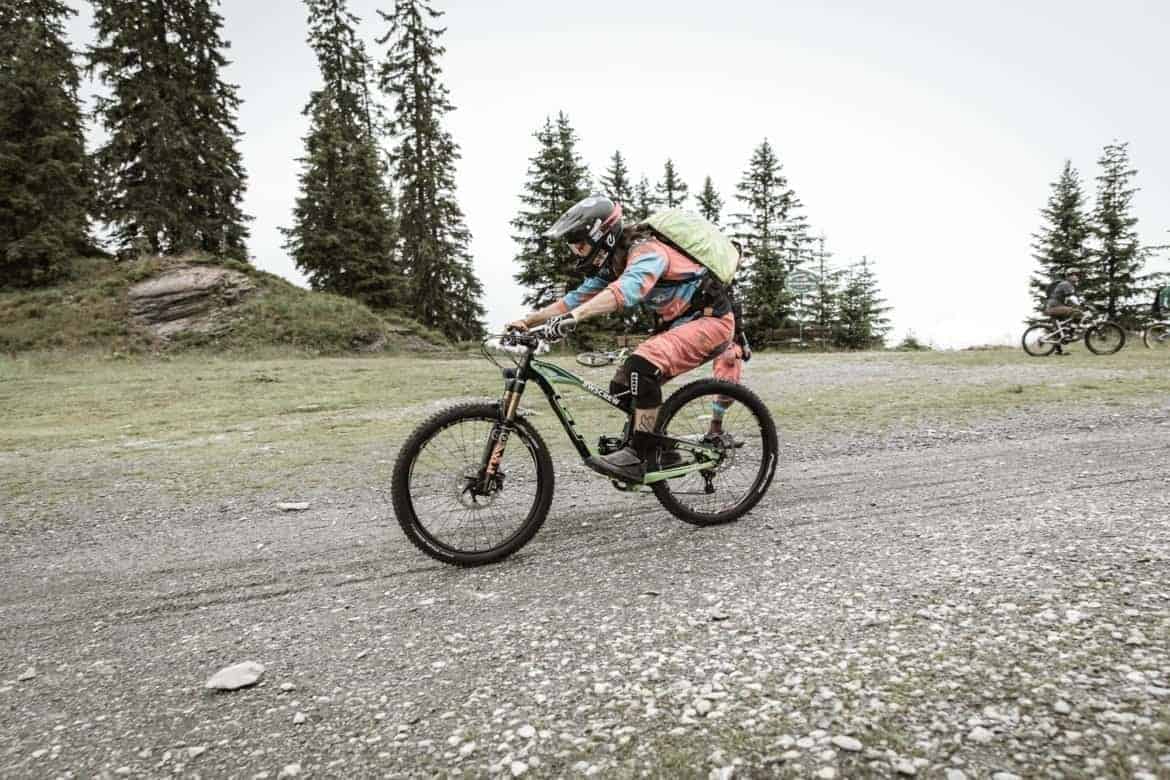If there were no friction, people and things would slide uncontrollably in space. That’s why, fortunately, there is friction.
Probably the essence of mountain biking in the mountains, because only with it can you overcome the steep curves and drops as desired.
Bike pro Daniel Kraut shows us how to use the brakes correctly at the Freeride Camp Saalbach Hinterglemm at the Bikehotel Barbarahof****.
Finger position
Today’s hydraulic disc brakes do not require a lot of force to be able to grip optimally. One finger should be enough, and therefore the distance of the brake lever must be set so that the fingers are relaxed and can react quickly.
“The remaining fingers on the handle provide better control for rough passages. And please always keep your thumb under the handle.” daniel emphasizes.
Body position
The pedals are horizontal and the body centre of gravity is above the bottom bracket. The body weight is evenly distributed on both pedals in the starting position. Arms and legs are slightly angled. The view is far forward.
Position during braking
The braking force and the successful outcome of a braking maneuver are influenced by the displacement of the body’s centre of gravity. If the braking process is initiated, the front and rear brakes are simultaneously dosed. At the same time, the weight is shifted backwards to prevent the rear wheel from losing traction. The flowing movement to the back is easier to kneel.
“The weight should always be distributed as evenly as possible so that there is never too little weight on one bike. Beginners often make the mistake of leaning too far back on steep descents. Then there is no more weight on the front wheel and it loses traction,” explains the expert.
Maximum braking force
If the obstacle, the route or a careless fellow rider requires an emergency stop, you have to support the disc brakes with a massive body shift.
The more you brake the further the body center of gravity moves backwards. Daniel pushes the handlebars forward, leaves the legs stretched and holds up the centre of gravity of the body, because the angle on the front wheel looks optimal like the body weight.
Brake exercises
The front brake has a much greater degree of activity than the rear brake. In order to counteract the risk of rollover, the body centre of gravity is moved to the rear. To find out how much you can strain the individual brakes, you practice the weight shift.
#1 The sensitivity for the front brake is practiced while walking. You push the bike on grippy ground next to you. By dispensing the front brake, you try to let the rear wheel rise and keep it as calm as possible. During this time, the front wheel should continue to roll evenly.
#2 Sitting on the bike and at medium speed, pull the front brake and shift your weight so far forward that the rear wheel rises in a controlled manner. Legs stay on the pedal. To set off, you release the brake, lean backwards and continue rolling. It is best to practice together with the guide, who can hold one on the handlebars and thereby give you security.
#3 When riding downhill, the rear wheel locks very easily and you lose control. In order to get a feeling for these situations, you practice pulling the rear brake on a slight descent. IMPORTANT: Pedals stand horizontally, body weight moves backwards. By emotional counter-steering, one tries to keep the blocking rear wheel in the lane.
Next, you try a maximum braking without blocking the rear wheel.
Steep terrain, such as the Bergstadl Trail in the Bike-Circus Saalbach Hinterglemm, shifts up to 90% of the braking force to the front tire. This means that you should always check that the front tire has sufficient traction.
A locked rear tire is to be avoided here. Only by minimizing the brakes can the wheel be controlled in such situations.
As a training tip, Daniel Kraut recommends a short descent using only the front brake. This gives the rider a good feeling of how much traction the front wheel really needs to be effectively controlled.
Freeride camp and technical training with Daniel Kraut
If you want to refine your technique and get the hang of every type of turn, a guide is the right choice. The right tips at the right time combined with video analysis and numerous repetitions will push you to the next level in no time at all.
The Bike Hotel Barbarahof Saalbach offers regular bike packages that offer everything a biker’s heart desires, from a secure bike garage to a freeride guide. With the Bike-Circus Saalbach Hinterglemm right on your doorstep and the Joker-Card in your pocket, you start a new adventure every day from the Hotel Barbarahof.
Season highlight: the annual Freeride Bike Camp with Daniel Kraut!
The professional and former Downhill World Cup starter discovered the Barbarahof**** in Saalbach and the surrounding trails for himself years ago and is happy to pass on his experience to enthusiastic beginners and advanced riders.
Now it’s just more practice, practice, practice. Ideally in a bike hotel like the Barbarahof**** in Saalbach Hinterglemm. Here, cranking know-how meets family hospitality.






